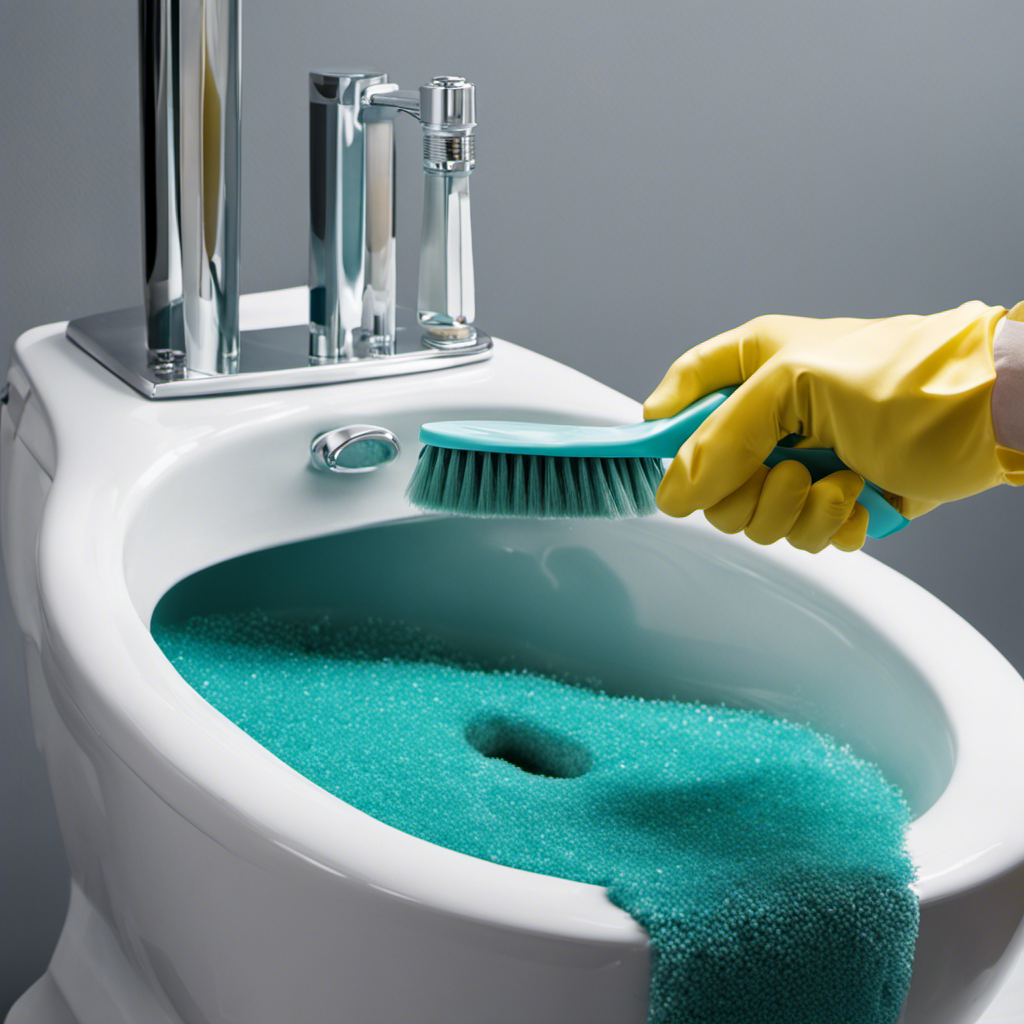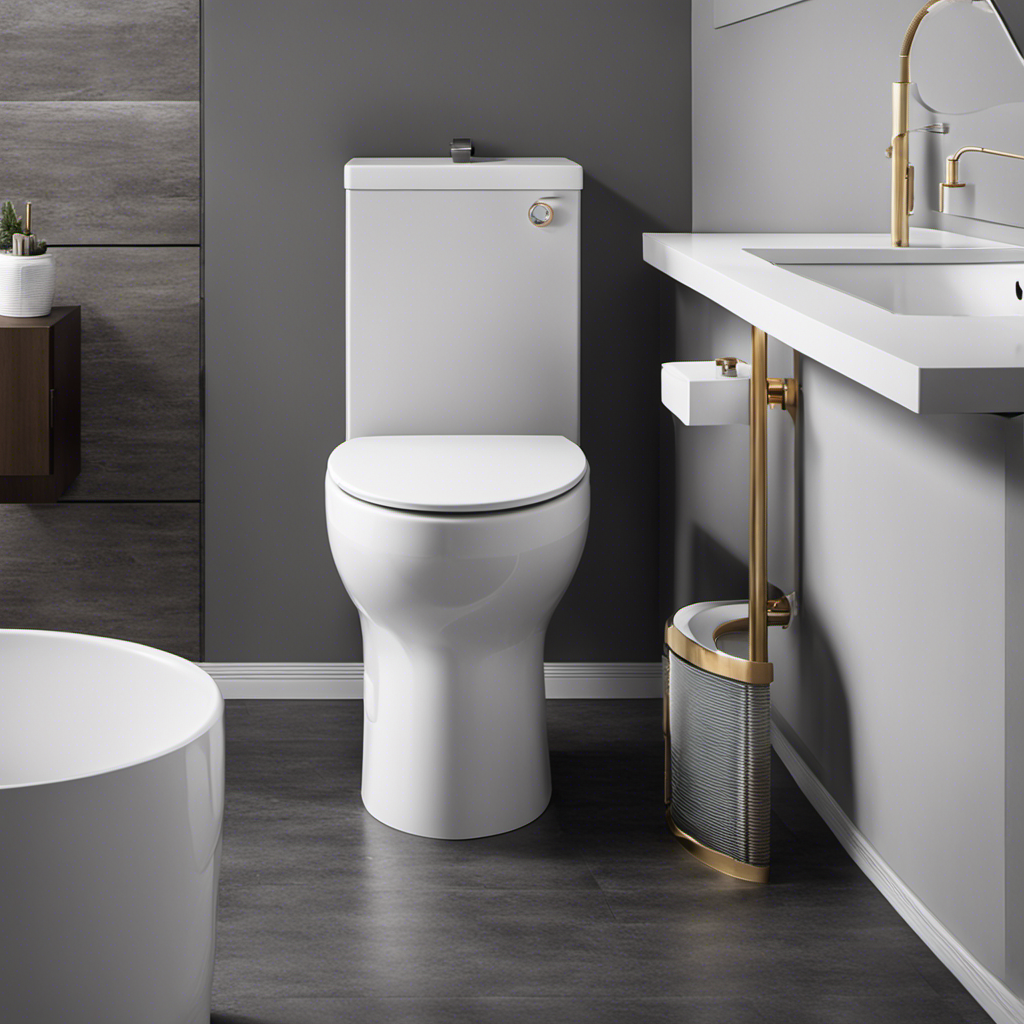As they say, ‘knowledge is power,’ and when it comes to understanding how a pressure assist toilet works, that knowledge can save you time, money, and water.
In this article, I will break down the intricate workings of this innovative bathroom fixture. From the pressure assist mechanism to the key components and installation process, we’ll explore every detail.
So, buckle up, because we’re about to dive deep into the world of pressure assist toilets and unveil their water-saving magic.
Key Takeaways
- Pressure assist toilets use compressed air to enhance flushing power.
- The force of pressurized air creates a more powerful flush.
- Pressure assist toilets do not solely rely on gravity for waste removal.
- Pressure assist toilets use significantly less water per flush compared to gravity-fed toilets.
The Basics of Pressure Assist Toilets
To understand the basics of pressure assist toilets, you need to know how they work.
Pressure assist toilets utilize compressed air to enhance flushing power and improve performance. When the toilet is flushed, water from the tank rushes into the bowl, but instead of relying solely on gravity to remove waste, pressure assist toilets use the force of pressurized air to create a more powerful flush.
The water and air combination creates a forceful push, effectively clearing the bowl and preventing clogs. This innovative design offers several benefits and performance advantages.
Firstly, pressure assist toilets provide a more thorough and efficient flush, ensuring a cleaner and fresher bowl. Secondly, they are less prone to clogging, reducing the need for maintenance and potential plumbing issues.
Overall, pressure assist toilets offer superior performance and improved hygiene, making them an excellent choice for both residential and commercial settings.
Understanding the Pressure Assist Mechanism
When it comes to efficient flushing technology, one key point to consider is the use of pressure assist mechanisms in toilets. These mechanisms utilize increased water pressure to enhance the flushing power, resulting in a more efficient and effective flush.
Efficient Flushing Technology
Efficient flushing technology in pressure assist toilets allows for a more powerful and effective flush. This innovative water saving technology utilizes compressed air, which creates a strong force to propel the water out of the bowl.
When the flush valve is opened, the compressed air is released, creating a sudden burst of pressure that pushes the water out with great force. Unlike traditional gravity-fed toilets, pressure assist toilets do not rely solely on the force of gravity to remove waste.
This results in a more efficient flush that effectively clears the bowl with less water. By using less water per flush, pressure assist toilets contribute to water conservation efforts and help reduce water consumption in households and commercial buildings.
Increased Water Pressure
The increased water pressure in pressure assist toilets ensures a more powerful flush. This increased pressure is achieved through the use of a compressed air system that pushes water into the bowl at a higher velocity.
Here are three key components that contribute to the increased water pressure and its impact on plumbing systems:
-
Pressure tank: The pressure tank stores the air that will be used to create the pressure for flushing. When the toilet is flushed, the air is released into the water, creating a forceful flush.
-
Flush valve: The flush valve is responsible for releasing the pressurized water into the bowl. It opens rapidly, allowing the water to rush out with great force.
-
Trapway design: The trapway, the curved passage at the base of the toilet, is specifically designed to handle the increased water pressure. It is wider and smoother, allowing for a more efficient evacuation of waste.
The increased water pressure in pressure assist toilets not only ensures a powerful flush but also contributes to increased water efficiency and has a positive impact on plumbing systems.
This transition into the subsequent section about how pressure assist toilets save water will further explore the water-saving benefits of these toilets.
How Pressure Assist Toilets Save Water
To understand how pressure assist toilets save water, you should know that they use a powerful burst of air to propel waste down the drain. This innovative technology not only ensures efficient waste removal but also incorporates water-saving features to reduce water consumption.
Unlike traditional gravity-fed toilets that rely solely on gravity to flush waste, pressure assist toilets use the force of compressed air to create a high-pressure flush. This results in a more effective flush using significantly less water.
By using less water per flush, pressure assist toilets help conserve water, making them an environmentally friendly choice.
Now that we understand how pressure assist toilets save water, let’s explore the key components that make this technology possible.
Key Components of a Pressure Assist Toilet
Now that you understand how pressure assist toilets save water, let’s take a closer look at the key components that make this technology possible.
Here are the three main components that contribute to the functionality and benefits of a pressure assist toilet:
-
Pressure Tank: This is the heart of the pressure assist toilet system. It stores compressed air that creates the necessary pressure for a powerful flush. When the toilet is flushed, the pressure tank releases the stored air, forcing water into the bowl with great force.
-
Flushometer: The flushometer is responsible for regulating the flow of water into the toilet bowl. It controls the release of the pressurized water from the pressure tank, ensuring a strong and efficient flush.
-
Bowl and Trapway: The bowl and trapway are designed to efficiently remove waste from the toilet. The pressure created by the pressure assist system helps to forcefully propel waste through the trapway, preventing clogs and ensuring thorough flushing.
These key components work together seamlessly to deliver the functionality benefits of a pressure assist toilet, such as water conservation, powerful flushing, and reduced clogging.
Installation Process for Pressure Assist Toilets
During installation, it’s important to follow these steps for a pressure assist toilet to function properly.
First, ensure that the water supply line is shut off before disconnecting the old toilet.
Then, remove the old toilet and inspect the flange to ensure it is in good condition.
Next, place a new wax ring on the flange and align the holes of the new toilet with the flange bolts.
Carefully lower the toilet onto the wax ring and apply even pressure to secure it in place.
Tighten the nuts onto the flange bolts, but be careful not to overtighten.
Finally, connect the water supply line and turn on the water.
Check for any leaks and flush the toilet several times to ensure proper functioning.
Maintenance Tips for Pressure Assist Toilets
When it comes to maintaining pressure assist toilets, there are three key areas to focus on:
-
Preventing clogs and leaks: It is important to properly dispose of waste and avoid flushing any non-flushable items.
-
Cleaning and disinfecting: Regular cleaning and disinfecting of the toilet and its components will help maintain optimal performance and hygiene.
-
Troubleshooting common issues: This can be done by checking the water pressure, inspecting the flapper, or adjusting the fill valve.
Preventing Clogs and Leaks
To prevent clogs and leaks in your pressure assist toilet, regularly inspect the flush valve for any signs of wear or damage.
Here are three key steps to ensure the optimal performance of your pressure assist toilet:
-
Check for any cracks or chips in the flush valve. These can cause water to leak out and compromise the flushing power of the toilet.
-
Clean the flush valve thoroughly to remove any mineral deposits or debris that may be obstructing the water flow. This will help maintain the efficiency of the flush and prevent clogs.
-
Replace the flush valve if necessary. Over time, the flush valve may wear out or become damaged, leading to leaks and inadequate flushing. By replacing it, you can ensure that your pressure assist toilet functions properly and avoids any potential issues.
Cleaning and Disinfecting
Regularly cleaning and disinfecting your pressure assist toilet is essential for maintaining hygiene and preventing the buildup of bacteria and odors. To ensure a thorough cleaning, follow these cleaning tips:
-
Use a mild, non-abrasive cleaner: Avoid harsh chemicals that can damage the toilet’s components. Look for a cleaner specifically designed for toilets.
-
Scrub with a soft brush: Gently scrub all surfaces of the toilet, including the bowl, tank, and seat. Pay extra attention to hard-to-reach areas where bacteria can accumulate.
-
Rinse thoroughly: After cleaning, rinse the toilet with clean water to remove any residue from the cleaner.
-
Disinfect regularly: Use a disinfectant option to kill bacteria and prevent the spread of germs. Look for disinfectants that are safe for use on pressure assist toilets.
Remember to always follow the manufacturer’s instructions when using cleaning products. By following these cleaning tips and using the right disinfectant options, you can keep your pressure assist toilet clean and hygienic.
| Cleaning Tips | Disinfectant Options |
|---|---|
| Use mild cleaner | Choose safe disinfectants |
| Scrub gently | Follow manufacturer’s instructions |
| Rinse thoroughly | |
| Disinfect regularly |
Troubleshooting Common Issues
If you’re experiencing common issues with your pressure assist toilet, troubleshooting can help you identify and resolve the problem. Here are three common problems you may encounter and some troubleshooting techniques to address them:
-
Weak Flush:
- Check the water pressure in your home as low water pressure can affect the flushing performance.
- Inspect the flush handle and flush cartridge for any signs of damage or blockage.
- Adjust the water pressure and replace any faulty parts to resolve this issue.
-
Constant Running:
- Check the flush valve for debris or leaks and clean or replace it if necessary.
- Inspect the fill valve for leaks or issues with the water supply.
- Adjust or replace the fill valve as needed to stop the constant running.
-
Noisy Operation:
- Check the water supply connections and tighten any loose fittings.
- Flush the toilet multiple times to remove trapped air if there are loud or unusual noises during operation.
- If the problem persists, contact a professional plumber for further diagnosis and resolution.
Comparing Pressure Assist Toilets With Traditional Models
When comparing pressure assist toilets with traditional models, you’ll notice a significant difference in their flushing power. Pressure assist toilets utilize a pressure vessel inside the tank to provide an extra boost of force during flushing. This results in a more powerful and efficient flush compared to traditional gravity-fed toilets.
The increased pressure ensures that waste is effectively removed with less water usage. This improved efficiency can lead to water savings over time.
However, there are some drawbacks to consider. Pressure assist toilets tend to be louder during operation due to the pressurized flushing mechanism. Additionally, they may require more frequent maintenance and repairs due to the complex design.
Despite these drawbacks, the benefits of increased flushing power and water efficiency make pressure assist toilets a popular choice for commercial settings and households looking to conserve water.
Conclusion
In conclusion, pressure assist toilets are a game-changer in the world of bathroom fixtures. Their unique mechanism, akin to a powerful engine purring beneath the surface, ensures efficient flushing while conserving water.
By harnessing the force of compressed air, these toilets effortlessly propel waste away, leaving a clean and fresh environment behind.
With easy installation and simple maintenance, pressure assist toilets are the epitome of reliability and innovation.
Embrace this technological marvel and let it be the roaring engine of efficiency in your bathroom.










